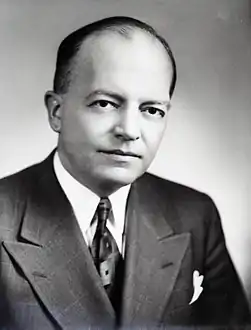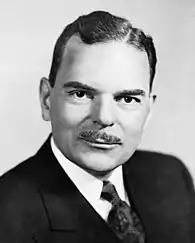1948 Republican Party presidential primaries
The 1948 Republican presidential primaries were the selection process by which voters of the Republican Party chose its nominee for President of the United States in the 1948 U.S. presidential election. The nominee was selected through a series of primary elections and caucuses culminating in the 1948 Republican National Convention held from June 21 to June 25, 1948, in Philadelphia, Pennsylvania.[1]
| |||||||||||||||||||||||||||||||||||||||||||||||
| |||||||||||||||||||||||||||||||||||||||||||||||
 Results map by state. | |||||||||||||||||||||||||||||||||||||||||||||||
| |||||||||||||||||||||||||||||||||||||||||||||||
Candidates
Both major parties courted general Dwight Eisenhower, the most popular general of World War II. Eisenhower's political views were unknown in 1948. He was, later events would prove, a moderate Republican, but in 1948 he flatly refused the nomination of any political party.
With Eisenhower refusing to run, the contest for the Republican nomination was between New York Governor Thomas E. Dewey, former Minnesota Governor Harold Stassen, General Douglas MacArthur, Ohio Senator Robert A. Taft and California Governor Earl Warren. Governor Dewey, who had been the Republican nominee in 1944, was regarded as the frontrunner when the primaries began. Dewey was the acknowledged leader of the GOP's powerful eastern establishment; in 1946 he had been re-elected Governor of New York by the largest margin in state history. Dewey's handicap was that many Republicans disliked him; he often struck observers as cold, stiff and condescending. Senator Taft was the leader of the GOP's conservative wing. He opened his campaign in 1947 by attacking the Democratic Party's domestic policy and foreign policy. In foreign policy, Taft was a non-interventionist who opposed many of the alliances the U.S. government had made with other nations to fight the Cold War with the Soviet Union; he believed that the nation should concentrate on its own problems and avoid "imperial entanglements". On domestic issues, Taft and his fellow conservatives wanted to abolish many of the New Deal social welfare programs that had been created in the 1930s; they regarded these programs as too expensive and harmful to business interests. Taft had two major weaknesses: he was seen as a plodding, dull campaigner, and he was viewed by most party leaders as being too conservative and controversial to win a presidential election. Taft's support was limited to his native Midwestern United States and parts of the Southern United States.
The "surprise" candidate of 1948 was Stassen, the former "boy wonder" of Minnesota politics. Stassen had been elected governor of Minnesota at the age of 31; he resigned as governor in 1943 and served in the United States Navy in World War II. In 1945 he had served on the committee which created the United Nations. Stassen was widely regarded as the most "liberal" of the Republican candidates, yet as the primaries continued he was criticized for being vague on many issues.
The following political leaders were candidates for the 1948 Republican presidential nomination:
Major candidates
These candidates participated in multiple state primaries or were included in multiple major national polls.
Competing in primaries
| Candidate | Most recent position | Home state | Campaign | ||
|---|---|---|---|---|---|
| Thomas E. Dewey |  |
Governor of New York (1943–54) |
 New York |
(Campaign) | |
| Douglas MacArthur | 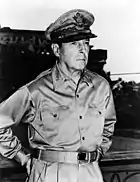 |
General of the Army (1944–51) |
 New York |
||
| Leverett Saltonstall |  |
U.S. Senator from Massachusetts (1945–67) |
 Massachusetts |
||
| Harold Stassen | 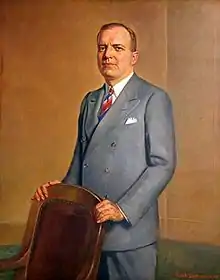 |
Former Governor of Minnesota (1939–43) |
 Minnesota |
(Campaign) | |
| Robert A. Taft | 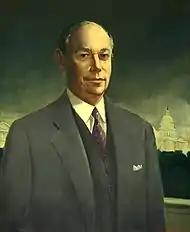 |
U.S. Senator from Ohio (1939–53) |
 Ohio |
(Campaign) | |
| Arthur Vandenberg |  |
U.S. Senator from Michigan (1939–53) |
 Michigan |
||
| Earl Warren | .jpg.webp) |
Governor of California (1943–53) |
 California |
||
Bypassing primaries
The following candidates did not actively campaign for any state's presidential primary, but may have had their name placed on the ballot by supporters or may have sought to influence to selection of un-elected delegates or sought the support of uncommitted delegates.
| Candidate | Most recent position | Home state | |
|---|---|---|---|
| Raymond Baldwin |  |
U.S. Senator from Connecticut (1946–49) |
 Connecticut |
| Dwight H. Green | .jpg.webp) |
Governor of Illinois (1939–49) |
 Illinois |
| Edward Martin |  |
U.S. Senator from Pennsylvania (1947–59) |
 Pennsylvania |
| Joseph Martin Jr. |  |
Speaker of the House (1947–49) |
 Massachusetts |
| B. Carroll Reece |  |
Chairman of the RNC (1946–48) |
Tennessee |
Favorite sons
The following candidates ran only in their home state's primary or caucus for the purpose of controlling its delegate slate at the convention and did not appear to be considered national candidates by the media.
- Businessman Riley A. Bender of Illinois
- Former U.S. Senator R.W. Hitchcock of South Dakota
Declined to run
The following persons were listed in a major national poll or were the subject of media speculation surrounding their potential candidacy, but declined to actively seek the nomination.
- Businessman and 1940 Republican nominee Wendell Willkie (died October 1944)
Polling
National polling
| Source | Publication | |||||||
|---|---|---|---|---|---|---|---|---|
| Gallup | Apr. 1945 | 59% | 7% | 1% | 15% | 2% | 4% | 1% |
| Gallup | Jan. 1946 | 38% | 6% | 2% | 27% | 4% | 4% | 1% |
| Gallup | Mar. 1946 | 37% | 3% | 1% | 33% | 3% | 6% | 1% |
| Gallup | Apr. 1946 | 35% | 5% | 1% | 34% | 3% | 5% | – |
| Gallup | July 1946 | 38% | 6% | – | 28% | 4% | 7% | – |
| Gallup | July 1946 | 37% | 4% | 1% | 25% | 5% | 8% | 6% |
| Gallup | Oct. 1946 | 40% | 5% | 1% | 22% | 6% | 7% | 6% |
| Gallup | Nov. 1946 | 52% | 2% | 1% | 17% | 2% | 9% | 5% |
| Gallup | Feb. 1947 | 45% | 3% | – | 18% | 8% | 8% | 3% |
| Gallup | Apr. 1947 | 51% | 2% | – | 15% | 7% | 10% | 3% |
| Gallup | June 1947 | 50% | 3% | – | 15% | 9% | 9% | 4% |
| Gallup | Jan. 1948 | 33% | 10% | – | 12% | 13% | 5% | 5% |
| Gallup | Mar. 1948 | 37% | 12% | 1% | 15% | 12% | 13% | 6% |
| Gallup | Mar. 1948 | 34% | 19% | 1% | 15% | 12% | 13% | 3% |
| Gallup | Apr. 1948 | 29% | 16% | – | 31% | 9% | 10% | 2% |
| Gallup | Apr. 1948 | 24% | 12% | – | 37% | 8% | 13% | 2% |
| Gallup | June 1948 | 33% | 11% | – | 26% | 10% | 13% | 2% |
Source:[2]
Primary campaign
Stassen stunned Dewey in the Wisconsin and Nebraska primaries, thus making him the frontrunner. He then made the mistake of trying to beat Senator Taft in Taft's home state of Ohio; Taft defeated Stassen on his home turf and Stassen earned the animosity of the party's conservatives. Even so, Stassen was still leading Dewey in the polls for the upcoming Oregon primary. However, Dewey, who realized that a defeat in Oregon would end his chances at the nomination, sent his powerful political organization into the state. Stassen also agreed to debate Dewey in Oregon on national radio – it was the first-ever radio debate between presidential candidates. The sole issue of the debate concerned whether to outlaw the Communist Party in the United States. Stassen, despite his liberal reputation, argued in favor of outlawing the party, while Dewey forcefully argued against it; at one point he famously stated that "you can't shoot an idea with a gun". Most observers rated Dewey as the winner of the debate, and a few days later Dewey defeated Stassen in Oregon. From that point forward, the New York governor had the momentum he needed to win his party's second nomination.
Statewide contests by winner
| Earl Warren | Harold Stassen | Robert A. Taft | Thomas E. Dewey | Riley A. Bender | Douglas MacArthur | Leverett Saltonstall | R. W. Hitchcock | Edward Martin | Arthur H. Vandenberg | Joseph W. Martin | Unpledged | ||
|---|---|---|---|---|---|---|---|---|---|---|---|---|---|
| March 9 | New Hampshire | - | - | - | - | - | - | - | - | - | - | - | 100% |
| April 6 | Wisconsin | - | 39.37% | - | 25.16% | - | 33.98% | - | - | - | - | - | - |
| April 13 | Illinois[3] (Results) |
- | 0.47% | 0.21% | 0.29% | 96.90% | 2.00% | - | - | - | - | - | - |
| April 13 | Nebraska | 0.95% | 43.54% | 11.62% | 34.54% | - | 3.71% | - | - | - | 5.16% | 0.49% | - |
| April 20 | New Jersey | 0.16% | 34.79% | 5.52% | 41.38% | - | 8.00% | - | - | - | 5.75% | 0.71% | - |
| April 27 | Massachusetts | - | - | - | - | - | - | 100% | - | - | - | - | - |
| April 27 | Pennsylvania | - | 31.47% | 5.88% | 29.82% | - | 7.07% | - | - | 17.46% | 3.42% | - | - |
| May 4 | Ohio | - | 43.21% | 56.79% | - | - | - | - | - | - | - | - | - |
| May 11 | West Virginia | - | 83.17% | - | - | - | - | - | - | - | - | - | - |
| May 21 | Oregon | - | 47.56% | - | 51.79% | - | - | - | - | - | - | - | - |
| June 1 | California | 100% | - | - | - | - | - | - | - | - | - | - | - |
| June 1 | South Dakota | - | - | - | - | - | - | - | 100% | - | - | - | - |
- Italics - Write-In Vote
Primaries total popular vote results:[4]
- Earl Warren - 771,295 (26.99%)
- Harold Stassen - 627,321 (21.96%)
- Robert A. Taft - 464,741 (16.27%)
- Thomas E. Dewey - 330,799 (11.58%)
- Riley A. Bender - 324,029 (11.34%)
- Douglas MacArthur - 87,839 (3.07%)
- Leverett Saltonstall - 72,191 (2.53%)
- R. W. Hitchcock - 45,463 (1.59%)
- Edward Martin - 45,072 (1.58%)
- Unpledged delegates - 28,854 (1.01%)
- Arthur H. Vandenberg - 18,924 (0.66%)
- Dwight D. Eisenhower - 5,014 (0.18%)
- Harry S. Truman - 4,907 (0.17%)
- Henry A. Wallace - 1,452 (0.05%)
- Joseph W. Martin - 974 (0.03%)
Convention
The 1948 Republican National Convention was held in Philadelphia, Pennsylvania. It was the first presidential convention to be shown on television. As the convention opened, Dewey was seen as having a large lead in the delegate count. His major opponents – Taft, Stassen, and Senator Arthur H. Vandenberg of Michigan – met in Taft's hotel suite to plan a "stop-Dewey" movement. However, a key obstacle soon developed when the three men refused to unite behind a single candidate to oppose Dewey. Instead, all three men simply agreed to try to hold their own delegates in the hopes of preventing Dewey from obtaining a majority. This proved to be futile, as Dewey's efficient campaign team gathered up the delegates they needed to win the nomination. After the second round of balloting, Dewey was only 33 votes short of victory. Taft then called Stassen and urged him to withdraw from the race and endorse him as Dewey's main opponent. When Stassen refused, Taft wrote a concession speech and had it read at the start of the third ballot; Dewey was then nominated by acclamation. Dewey then chose popular Governor Earl Warren of California as his running mate. Following the convention, most political experts in the news media rated the GOP ticket as an almost-certain winner over the Democrats.
| Ballot | 1 | 2 |
|---|---|---|
| NY Governor Thomas E. Dewey | 434 | 515 |
| OH Senator Robert A. Taft | 224 | 274 |
| Frm. MN Governor Harold Stassen | 157 | 149 |
| MI Senator and President pro tem Arthur Vandenberg | 62 | 62 |
| CA Governor Earl Warren | 59 | 57 |
| House Speaker Joseph Martin | 18 | 10 |
| General Douglas MacArthur | 11 | 7 |
References
- Kalb, Deborah (2016-02-19). Guide to U.S. Elections - Google Books. ISBN 9781483380353. Retrieved February 19, 2016.
- "US President - R Primaries (Polling)". OurCampaigns. 19 Aug 2015. Retrieved 30 Mar 2020.
- Illinois Blue Book 1947-1948. Illinois Secretary of State. p. 747. Retrieved 29 March 2020.
- Our Campaigns - US President - R Primaries Race - Feb 01, 1948

